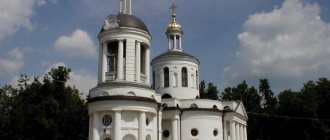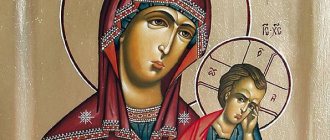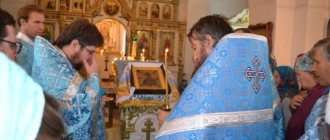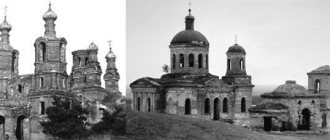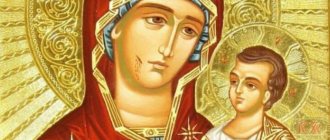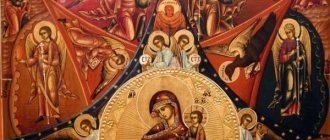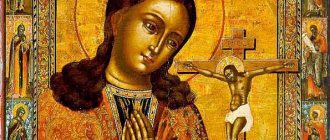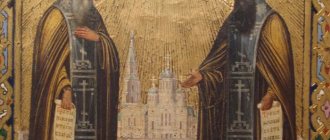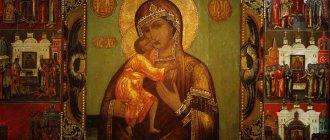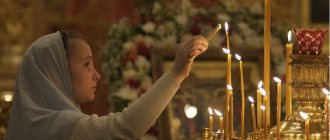Blachernae Icon - a shrine of the Golovin family
In the village of Dedenevo, Dmitrovsky district, there is the Spaso-Vlakhernsky convent, founded in the mid-19th century with the support of the village owners Anna Gavrilovna and Gabriel Pavlovich Golovin. The revered shrine of the monastery, the Blachernae Icon of the Mother of God, was preserved, despite the years of destruction of the monastery in the 20th century, and returned to Dedenevo in the early 2000s. The unusual relief image of the Virgin Mary is an ancient copy of the Blachernae image from the Assumption Cathedral of the Moscow Kremlin.
In August there are three “Spas” in the Orthodox Church: August 1 of the church calendar, August 6 – “Apple”, and August 16 – “Nut”. All three “Spas” fall on the Dormition Fast, although the third is always postponed by one day, so as not to combine it with the feast of the Dormition of the Virgin Mary. According to the modern civil calendar, “Spasy” is celebrated on August 14, 19 and 29, respectively.
The August “Spas” was often reflected in the names of villages where the patronal feast day of the local church fell on one of these three days. For example, the village of Zhuravna of the present Zaraisky district was called Spas-Zhuravna, Bolshoye Runovo in the Kashira district was Spas-Detchin, and Spas-Ugol of the Taldomsky or Spas-Zaulok of the Klinsky districts still officially have such names today. Before the revolution, the village of Dedenevo near Dmitrov was more often called Novospasskoye-Dedenevo or simply Novospasskoye, thanks to the church, and then the convent dedicated to the Savior Not Made by Hands.
All three August “Spas” in their folk-gastronomic aspect seem interconnected and consistent, but in their church content these holidays hardly have the same clear connection with each other. Honey Savior is a holiday of the Origin of the honest trees of the life-giving cross of the Lord, dedicated to the Byzantine custom of bringing out for worship on this day an authentic piece of the tree of the cross of Christ, which was once kept in the Hagia Sophia Cathedral in Constantinople. The Transfiguration of the Lord is called the Apple Savior when one remembers the mysterious event of the transfiguration of Christ described in the Gospels before three of his closest disciples during prayer on a secluded hill. The Nut Savior is a church holiday of the transfer of the Image of the Savior Not Made by Hands from Edessa to Constantinople. The miraculous image is a canvas on which, according to ancient legend, the face of Jesus Christ was imprinted by itself when he, having wetted his face, wiped it with a cloth and gave it to the ambassador of the King of Edessa. It is this last “Savior” that the Spaso-Vlaherna Monastery in Dedenevo is dedicated.
The appearance of the Spasskaya Church and monastery in Dedenevo is associated with the noble family of Golovins, in whose hands the village was located starting from the second half of the 17th century. In 1713, steward Vasily Petrovich Golovin built a wooden church here in honor of the icon of the Image of Christ the Savior Not Made by Hands, with which, according to family legend, the Moscow Grand Duke Vasily Dmitrievich blessed the founder of the Golovins, Stepan Vasilyevich Khovra. Stepan Vasilyevich Khovra was a representative of one of the branches of the Greek family of Komnenos. In the 15th century, he moved from the Byzantine colonies of Crimea to Moscow, where he later became the progenitor of the Khovrins, Golovins and Tretyakovs.
At the end of the 18th century, the church in Dedenevo was built in brick, and in subsequent years it was completed and expanded. The idea to transform the parish church into a convent belonged to Anna Gavrilovna Golovina and her eldest son Gavriil Pavlovich. In 1852, the church authorities granted their petition and allowed them to open a Vlaherna women’s hostel in Dedenevo, which a few years later was transformed into a full-fledged nunnery. In the 20th century, the monastery suffered greatly, first from the anti-religious policies of the Soviet government, and then from German bombs during fierce battles at Peremilovskaya Heights in 1941. By a happy coincidence, the revered shrine of the Golovin family and their Dedenevsky monastery - the Blachernae image of the Mother of God - has been preserved.
The original Blachernae image was brought to Moscow from Constantinople, conquered by the Turks, by a Greek clergyman named Gabriel as a gift to the Moscow Tsar Alexei Mikhailovich. In that era, ties with the Orthodox East were actively being established. Priests from Jerusalem, Syria, and the Balkans often began to come to Moscow, asking for alms from the Moscow Tsar of the same faith. The Blachernae icon of the Mother of God was once the patroness of the Byzantine emperors, but after the fall of Constantinople it was in danger of destruction. To save the image from invaders, the icon was hidden by embedding it in the window opening of the church of the Orthodox monastery. After some time, this Greek monastery was converted into a mosque, and one of its servants discovered a Christian icon hidden in the wall. The Turk decided to sell it to a certain Greek widow, who, in turn, gave the image to Gabriel, who was setting off with a message to Rus'.
Brought from the former Byzantine Empire, the icon became very revered by Tsar Alexei Mikhailovich. He saw in it a symbol of the fact that from now on the Mother of God, who once patronized the Greek kings, but retreated from them, will now help the new Orthodox kingdom. The Blachernae icon was kept in a place of honor in the main Assumption Cathedral of the Moscow Kremlin, and on Saturday in the fifth week of Lent a special solemn service was performed in front of it. By the way, this image is still kept in the Assumption Cathedral of the Kremlin as a museum exhibit.
Three copies were made from the original of the Assumption Cathedral of the Kremlin: for the Vysoko-Petrovsky Monastery in Moscow, for the Vlakhernskoe-Kuzminki estate, and for the Golovins. Like the Kremlin original, all three of its copies have also survived. The Kuzminsky list is in the Tretyakov Gallery, and the list of the Vysoko-Petrovsky Monastery, by historical irony, today is in another Moscow monastery - Simonov. This monastery appeared and received its name thanks to the already mentioned Stepan Khovra, the ancestor of the Golovins, who at the end of his life took monasticism with the name Simon. For centuries, the Simonov Monastery housed the family tomb of the Khovrins and Golovins.
The third Dedenev list of the Blachernae icon was the main relic among several hundred shrines that the Golovins collected over several centuries and kept in their home. After the construction and consecration of the Spassky Cathedral, these ancestral shrines became the decoration of the Blachernae convent. The cathedral had nine thrones, and the central iconostasis for it was brought from the Alekseevsky Monastery, which was abolished in Moscow, on the site of which the construction of the Cathedral of Christ the Savior had just begun. Unfortunately, a large collection of Golovins disappeared without a trace in the 20th century, but the Blachernae image was preserved thanks to the work of art historians and restorers, who, in the difficult post-revolutionary times, convinced the authorities to place the icon in the Dmitrov Museum. Then the icon was transported to the Andrei Rublev Museum in Moscow, and in 2015 this relic near Moscow returned to its historical place in the Spassky Cathedral of the Blachernae Monastery.
The history of the painting of the holy face
The Icon of the Mother of God of Blachernae is considered the oldest in the world - the date of its composition dates back to the year 302.
The authorship is attributed to Christ's disciple, Luke, but there is no exact data confirming this fact. According to legend, Luke wrote it in Antioch, where it was kept. It first became known when Empress Eudokia transported the image to the capital of Byzantium in 439. Evdokia gave it as a gift to the emperor’s sister, and she, in turn, gave the icon for storage in Blachernae, in the Church of the Virgin Mary. That is why from that time the image began to be called Blachernae.
Blachernae Icon of the Mother of God
The image was considered the patron saint of Constantinople, since during the attack of the Avars, Patriarch Sergius made a religious procession with her around the walls of the city and prayed to the icon for liberation, which did not take long to happen. This happened on Saturday of the fifth week before Easter, so since then this day has been considered the feast of the Blachernae Icon, which was first celebrated only in Constantinople, and a few years later throughout the world by the Orthodox Church.
In 1654, the Blachernae icon went to Emperor Alexei Mikhailovich, but the exact reason is unknown:
- The first version says that the monks saved the image from the Turks, who captured the capital of Byzantium.
- The second is that the icon was kept in a convent, and when a mosque was erected in its place, the Christians who remained there sent it to Russia.
For two centuries, the relic was kept in the Kremlin Assumption Church, and later, after the cathedral was closed to parishioners, it was transferred to the Church of the Exaltation of the Cross on Voznesenka. The icon returned to the Kremlin (to the State Museum) in 1931, when the temple on Voznesenka was destroyed by the communists.
During the 17th and 18th centuries, several lists were made from it, the most famous of which are:
- Blachernae image, stored in the Tretyakov Gallery;
- image kept in the temple in Kuzminki.
Attention! The original image is kept today in the State Kremlin Museum, as part of a collection of relics.
Description of the icon
The Virgin Mary on the Blachernae icon belongs to the Hodegetria type, i.e. showing the way. The main feature of the board is that it was made using the wax-mastic technique - the icon painter mixed wax with the relics of martyrs and applied the mixture to a flat tree on which the relief of the future image was carved. Paint is applied on top of the mastic.
Ancient list of the Blachernae Icon of God
Important! Due to the specific nature of creating the image, only a few lists were made from it - less than five pieces.
The dimensions of the board are 6 × 37.5 × 4 cm, and due to the special writing technique, the impression of a three-dimensional image is created, as if protruding beyond the board. The Virgin Mary is depicted from the waist up, with Christ in her arms. The figure of the Mother is massive, the halos of the figures are also greatly enlarged so that they overlap the strip of fields. The characters are dressed in purple dresses, which indicates their high royal position.
More Mother of God icons:
- Tsaregradskaya
- Quench my sorrows
- Three-handed
Lists
There are three known lists of the icon, made at different times:
- belonged to the Stroganov family, and from the mid-18th century to the Golitsyn family. The icon was kept on an estate in the village of Blachernae (Kuzminki) near Moscow, where a church was built, consecrated in honor of the Blachernae icon. Currently this list is kept in the Tretyakov Gallery. The first mention of the icon dates back to 1716, but according to the dating of G.V. Sidorenko, the image dates back to the 7th century. The ancient origin of the icon is connected with the family legend of the Stroganovs and Golitsyns that not one, but two icons were brought to Tsar Alexei Mikhailovich from Constantinople. The possibility of making a copy of the icon using a technique similar to the prototype is evidenced by a written instruction on the composition of the mastic and casting - “On the compilation of an icon, a decree on how the image is constructed of the Blachernae Most Holy Theotokos” from a 17th-century collection;
- from the Church of St. Sergius of Radonezh in the Moscow Vysoko-Petrovsky Monastery (established in 1701), currently kept in the Church of the Nativity of the Virgin Mary in Stary Simonovo);
- from the Spaso-Vlaherna Monastery near the city of Dmitrov (one of the shrines of the Golovin family, created in 1705, currently located in the Andrei Rublev Museum).
The second and third lists are exact copies of the Kremlin icon; they had similar precious frames with an inscription about the salvation of the icon of Constantinople from enemies through the intercession. In imitation of the original, these two lists are made as reliquary icons - the crowns are “filled with many particles of the holy relics of various saints of God.” In the descriptions, these icons are called wax-mastic, but in fact they are relief wooden images, covered with gesso and painted with tempera, that is, they differ from the Byzantine prototype.
